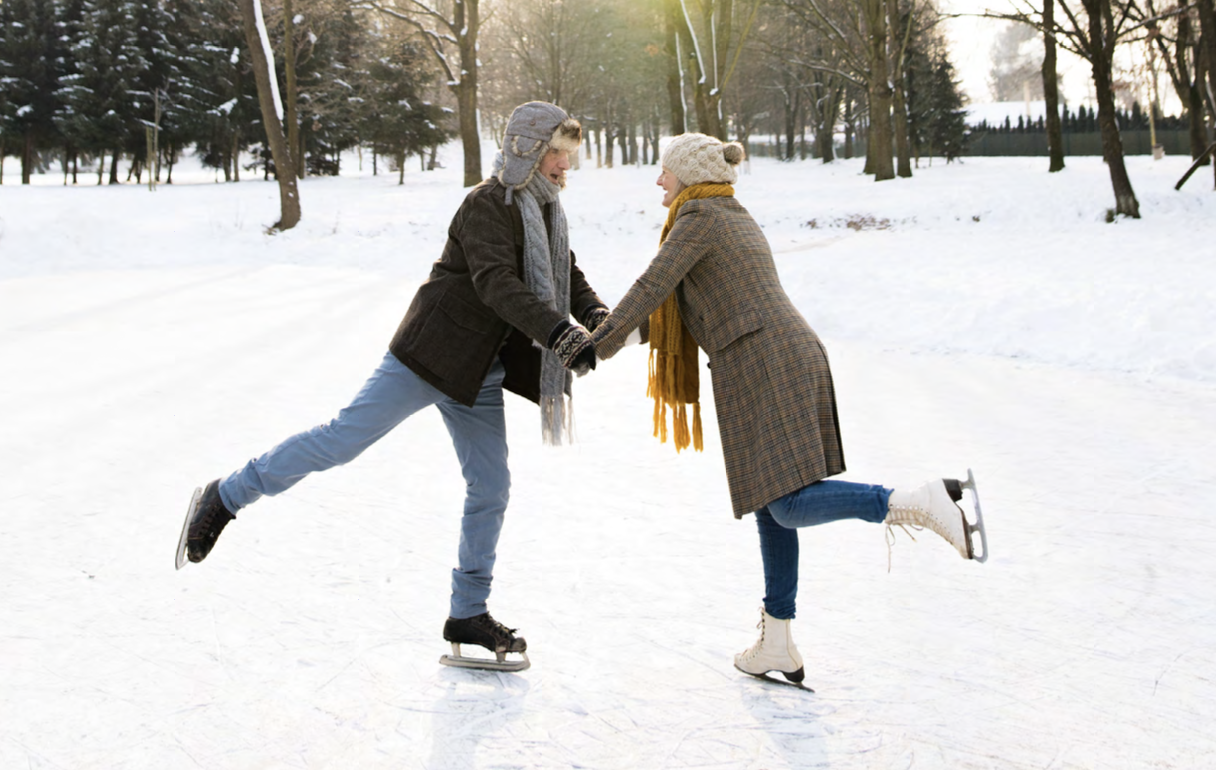By Wendy Haaf
An impaired sense of balance can result in a loss of independence or even a fall. While the changes that lead to balance problems are a part of getting older, you can take action to keep your balance in good shape
After the first COVID-19 restrictions were imposed in Canada, Doreen Carter*, now 84, had to stop attending her in-person fitness classes. Many months later, she noticed that it was affecting her. “I lost a lot of my physical strength,” the Windsor, Ont., retiree says. And while she probably wouldn’t have picked up on it otherwise, regular self-monitoring revealed that her balance had deteriorated. “I knew by testing myself with balance tests I’d gone through before.” The length of time she could stand on one leg—on both her dominant and non-dominant sides—had shrunk.
At an age much younger than Carter’s, all of us experience physical changes that can begin eroding our balance, a process that occurs so gradually and silently that most people remain unaware of it. “About age 40 is when it really starts to change,” says Susan Hunter, a physiotherapist, associate professor, and faculty scholar in the School of Physical Therapy at Western University in London, Ont. And unless we take steps to preserve it, our sense of balance continues to worsen as we age, which can ultimately affect our ability to live independently.
Hunter likens balance to a complex piece of orchestral music that requires many different musicians to work together. Khrista Boon, program supervisor for the Victorian Order of Nurses’ (VON) Erie St. Clair district SMART Exercise and Fall Prevention Program in Windsor, Ont., describes it this way: “Good balance requires the coordination of many different systems in our body—the central nervous system, inner ear, eyes, bones, and joints.”
After we reach peak muscle mass at about 30 years old, we “slowly begin to lose that muscle mass, and that accelerates exponentially after age 65,” explains Dr. Manuel Montero-Odasso, a geriatrician and director of the Gait and Brain Lab at St. Joseph’s Health Care’s Parkwood Institute and a professor in the Schulich School of Medicine & Dentistry at Western University in London, Ont.
Consequently, “we lose our strength and power, which makes our muscles weaker, so we’re less able to recover if we trip, or our muscles can’t control our posture as well as they could when we were younger,” says Brian Dalton, an associate professor and researcher in the Sensorimotor Physiology and Integrative Neuromechanics Lab in the School of Health and Exercise Sciences at the University of British Columbia’s Okanagan Campus in Kelowna. At the same time, he adds, “there are changes in our sensory systems,” all of which can have additive effects. For one, the number of nerves in a crucial balance system located largely in the inner ear—the vestibular system—begins to decrease. “Our vestibular system measures the accelerations of our head,” Dalton explains. With a decline in function due to fewer nerves, the brain is less able to tell where we are in space, “and if we don’t know that, we can’t respond well enough to keep our body upright”—particularly in situations requiring rapid reflexes, such as when we’re standing on a bus that stops abruptly.
A similar decline occurs within another network of sensors, too. “We have receptors in our muscles as well as our skin,” Dalton says, offering the example of the skin on the soles of the feet. “[These receptors] detect pressure changes on our feet, as well as the stretch of the skin, which allows the body to know how we are swaying or how we are moving across the floor.” When these sensors become less sensitive, it can hinder “our ability to stay upright and allows us to sway more—to move more when we’re standing—which could lead to falls.”
In addition, standing requires greater brain bandwidth when we get older, which is due in part to changes in attention, executive function, and working memory. “As a young adult, we don’t have to think about standing as much as we do when we’re older,” Dalton says. “A good example is walking and talking at the same time. Younger people can walk continuously and have an engaging conversation.” Older people, on the other hand, have to either slow down or stop walking periodically as they talk, “because they need more of the resources of their brain to focus on balance control,” he explains.
It turns out that measuring walking speed while talking can flag dementia risk in at least one high-risk group. “Our research demonstrates that it’s normal to slow down by about 20 per cent,” Montero-Odasso says. Among people with mild cognitive impairment, “those who are unable to do these two tasks or who slow down more than 20 per cent are more likely to go on to develop dementia when you compare them to older adults who are able to walk and talk at the same time,” he explains.
Protect Yourself
A host of other circumstances that commonly occur with aging can compound the effects of these age-related changes.
Hearing plays a role in balance, so undetected and untreated hearing loss can potentially impair it. Balance also depends to an extent on vision, which can silently compensate for other less apparent changes up to a point. This means that regular eye checks and any necessary updates to eyeglass prescriptions are crucial. (It’s also important to be aware that bifocals—especially at first, and in certain situations, such as when you’re using stairs—can be a problem: “bifocals create a risk for falls because they distort the environment,” Hunter notes.
Some medications and drug interactions can potentially sabotage balance, too. For instance, sedation is a common side effect of many drugs, and “that will affect your balance because it reduces your processing speed and how fast your reflexes are, which are very important to keeping your balance,” Montero-Odasso says.
Medical conditions that are prevalent after age 55 can also cause changes with the potential to weaken balance. “High blood pressure and high cholesterol may cause micro-damages in the brain,” Montero-Odasso says. “So you don’t have a stroke, you don’t have a heart attack, but these areas of damage may be enough to alter your balance.”
However, despite this depressing litany of losses, it’s still possible to bolster your sense of balance so you can remain active and independent. “When you look at the top three risk factors for falls—balance problems, gait problems, and lower-extremity-strength issues—they’re all changeable,” Hunter says.
Activities and exercises that strengthen the muscles in the legs and core are one key element. (You’ll find three helpful exercises on page TK.) “How fast you react to a trip is definitely related to your muscle strength and power and how rapidly your nerves activate your muscles,” Dalton says. “You can work on that with power or strength training.”
This can include a wide range of movements that use your own body weight to work against gravity, from lunges and squats to the stances used in yoga and tai chi. Boon says that SMART Program classes “also incorporate exercises that target core and posture, like the seated or standing cross crunch, where you’re touching your elbow to the knee.”
Activities that involve getting up from and down to the floor or ground are also helpful. For example, Devon Konrad, a registered physiotherapist, vestibular therapist, and owner of Ladner Village Physiotherapy Inc., in Ladner, B.C., prescribes the following to maintain lower-body strength: “If someone has grandkids, I want them playing on the floor with their grandkids. Sit on the ground and play Duplo with the three-year-old. That regular practice of getting down on the floor and up again means you don’t lose it nearly as quickly.”
Another category of activities that has been studied and shown to improve balance control is what Dalton calls “dual-task training.” As the name implies, this involves “practising performing multiple tasks at once, such as doing a balance task while counting backwards by seven,” he says. “We want to do exercises that challenge coordination, thinking, planning, and reacting,” Boon adds. “So we do things like walking and bouncing or catching a ball or reciting the alphabet while marching and walking.”
A third group of exercises or activities Dalton recommends help train the balance system in general. “Dance, yoga, and tai chi have all been shown to help with balance control as well,” he says. These three examples all incorporate strength, concentration, and balance components. But so do some sports that might not immediately come to mind. “Take lawn bowling,” Konrad says. “You’re aiming, you’re in a lunge position, you’re looking at a target that’s moving, so your vestibular and proprioceptive systems have to be engaged because you’re using your vision for something else.” (Proprioception is the system that allows you to sense where you are in space.)
“We do standing and seated balance challenges [in our classes],” Boon says. “We want to improve responses to changing our base of support, so we do things like the four-stage balance test.” This is a series of progressively more difficult positions you try to hold for 10 seconds each, starting with your feet together and ending with you standing on one foot. “We also practise losing balance and having to take that sidestep to engage or re-engage our base of support and our centre of gravity,” she adds.
Push Your Limits
There are still more activities that challenge your vestibular system. “One of my exercises for parents is to wrestle and roughhouse with their kids,” Konrad says. “Tickle-fighting and throwing each other around a little bit and going to the playground and playing on the swings all provide wonderful vestibular rehab.”
Like playing on swings, exercises aimed at training your balance system can induce feelings of discomfort, such as wobbliness or nausea—and that’s actually a positive sign. “There’s a fabulous body of research about motor planning and motor learning that shows if you’re not failing, you’re not learning,” Konrad explains. “If you’re within the limits of your comfort, you’re not going to improve. As a therapist, I need to push you outside of your comfort zones. Otherwise there’s no reason for your brain to change.”
Hunter concurs. “In order for someone to get better, they have to be challenged to close to the maximum, so it means they have to be wobbly,” she says.
A group class may not always be the best forum for learning to push your limits. If you lack confidence in your balance, working one-on-one with a physiotherapist can help. “Sometimes it’s good to have a specialist who can work with you to find that sweet spot—where you’re physically challenged but also comfortable with that degree of wobbliness,” Hunter says. Physiotherapists can also pinpoint physical limitations that interfere with balance, such as limited range of motion in the ankle or knee, and prescribe targeted exercises to address these.
If you’re not in need of such personalized attention, on the other hand, a community-based exercise program for people 55 or older can be a good starting point. Osteofit, originally designed for people with osteoporosis, is a good example. “It’s wonderful because it combines balance and strength training,” Konrad says.
Finding activities that train your balance system while being enjoyable enough that you’ll do them on a regular basis is one of the best things you can do to reduce your risk for falls, fend off loss of function, and improve your overall quality of life. “Sometimes we encounter the objection ‘I’m too old to improve my balance,’ but our participants exemplify that it’s possible,” Boon says. “I get cards, emails, and voicemails weekly from participants who have seen an improvement in their balance, strength, coordination, and most importantly, their mental health. It’s never too late.”
When Carter walked into her local library and saw a SMART Program class in progress, she jumped at the chance to join. She’s since added exercise sessions offered by a seniors’ club where she’s a long-time member. “It’s made a big difference,” she says. “My energy level is better.” What’s more, her results on that do-it-yourself balance measure have rebounded. “I can balance for almost 20 seconds on my dominant leg and not quite 20 seconds on my non-dominant, and 20 seconds was always the marker for what was a good length of time to be able to do that.”
* Name changed for reasons of privacy.
Resources
balanceanddizziness.org features an excellent explanation of the balance system.
parachute.ca has an extensive list of videos and other resources on preventing falls.





